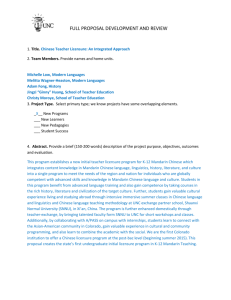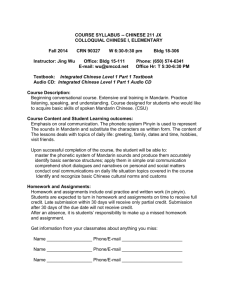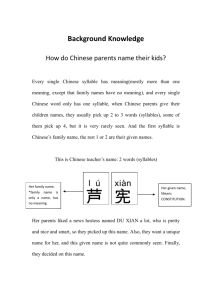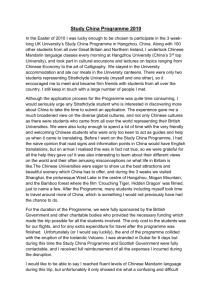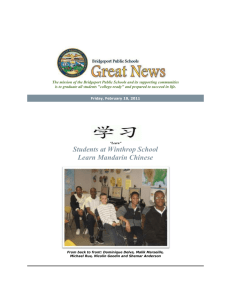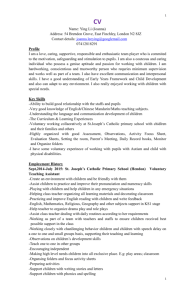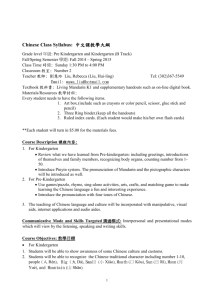Mandarin
advertisement
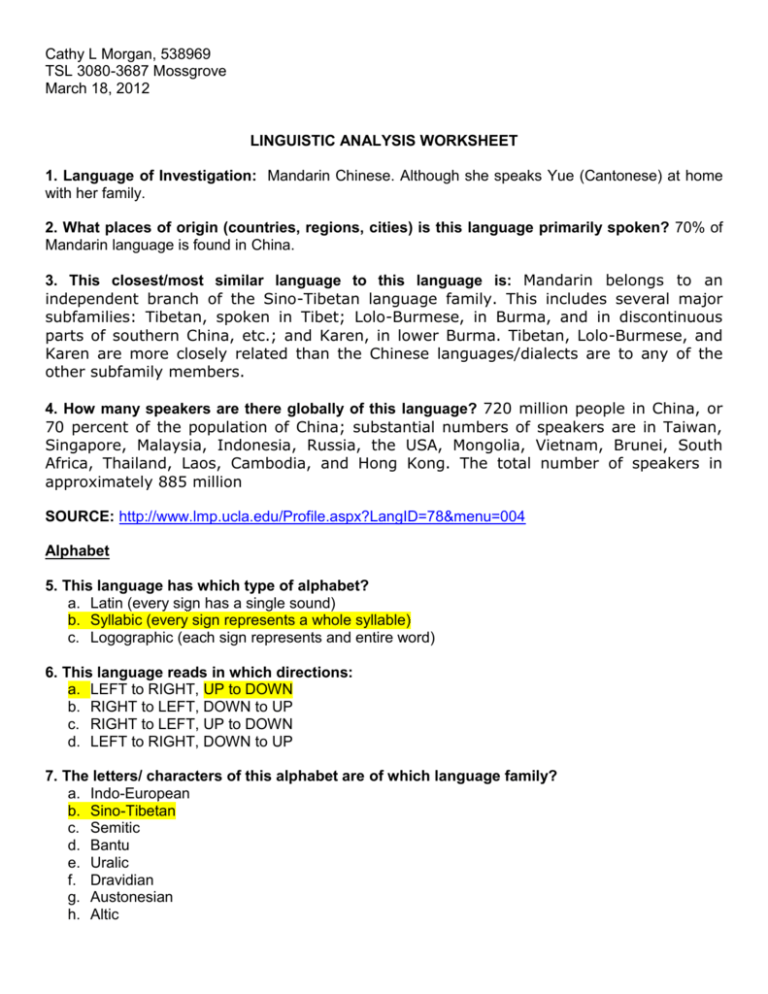
Cathy L Morgan, 538969 TSL 3080-3687 Mossgrove March 18, 2012 LINGUISTIC ANALYSIS WORKSHEET 1. Language of Investigation: Mandarin Chinese. Although she speaks Yue (Cantonese) at home with her family. 2. What places of origin (countries, regions, cities) is this language primarily spoken? 70% of Mandarin language is found in China. 3. This closest/most similar language to this language is: Mandarin belongs to an independent branch of the Sino-Tibetan language family. This includes several major subfamilies: Tibetan, spoken in Tibet; Lolo-Burmese, in Burma, and in discontinuous parts of southern China, etc.; and Karen, in lower Burma. Tibetan, Lolo-Burmese, and Karen are more closely related than the Chinese languages/dialects are to any of the other subfamily members. 4. How many speakers are there globally of this language? 720 million people in China, or 70 percent of the population of China; substantial numbers of speakers are in Taiwan, Singapore, Malaysia, Indonesia, Russia, the USA, Mongolia, Vietnam, Brunei, South Africa, Thailand, Laos, Cambodia, and Hong Kong. The total number of speakers in approximately 885 million SOURCE: http://www.lmp.ucla.edu/Profile.aspx?LangID=78&menu=004 Alphabet 5. This language has which type of alphabet? a. Latin (every sign has a single sound) b. Syllabic (every sign represents a whole syllable) c. Logographic (each sign represents and entire word) 6. This language reads in which directions: a. LEFT to RIGHT, UP to DOWN b. RIGHT to LEFT, DOWN to UP c. RIGHT to LEFT, UP to DOWN d. LEFT to RIGHT, DOWN to UP 7. The letters/ characters of this alphabet are of which language family? a. Indo-European b. Sino-Tibetan c. Semitic d. Bantu e. Uralic f. Dravidian g. Austonesian h. Altic 8. Does this language depend primarily on tone or pitch? a. Yes. Mandarin is a tone language in which each stressed syllable has a significant contrastive pitch which is an integral part of the syllable. All Chinese languages/dialects have tone, but Mandarin has one of the simplest systems, consisting of four basic tones (high level, high rising, dipping/falling, high falling) in contrast to Cantonese, for example, with nine contrastive tones. b. No 9. Is this language syllable or stress timed? a. Syllable timed b. Stress timed 10. Does this language have strong sound/symbol correspondence? (English does not) a. Yes b. No. There is little connection between the written and spoken language: the Chinese system of writing, for the most part, does not symbolize the spoken language. SOURCE: http://sonicnovel.com/kanjia.html and http://www.lmp.ucla.edu/Profile.aspx?LangID=78&menu=004 Directions: Complete this section ONLY if your language is Latin based (most languages you will encounter are). Phonetics and phonology 11. There are _____ vowels in this language. 12. They are (cut and paste the vowels in the actual script) ___________________________. 13. Which vowels sound the same as English vowel sounds? (list L1 vowel and English vowel correspondence). ___________________ 14. Which vowel sounds do not exist in English? ____________ 15. There are __________ consonants in this language. 16. They are (cut and paste the consonants of the actual script) __________________. 17. Which consonant sounds do NOT exist in English?____________________. 18. What sounds do speakers of this language have difficulty pronouncing?_______________ 19. Are there any sound placements that are different between English and this language? 20. What are they? (For example, _______________________ 21. Do any double letter combinations exist in this language? _________ 22. What are they and what do they correspond to in English? (For example, Spanish: /ll/ = English /y/). Syntax and Grammar 22. How many tenses exist in this language? The concept of time in Chinese is not handled through the use of different tenses and verb forms, as it is in English. 23. What are they? Mandarin Chinese has no grammatical tense, instead indicating time of action from the context or using adverbs. However, the auxiliary verb 会 huì, a modal meaning "can", "know how", can alternatively indicate futurity.[3]:p.265;[13]:p.183 For lexical futurity, the word 要 yào, which can serve as a verb meaning "to want", can also serve as an adverb meaning "immediately": [13]:p. 175 For example, 我要洗澡 wǒ yào xǐzǎo can mean either "I want to bathe" or "I am about to bathe". SOURCE: http://en.wikipedia.org/wiki/Future_tense#Mandarin_Chinese 24. The word order of this language is: a. Verb, subject, object (VSO) b. Subject, verb, object (SVO) c. Object, verb, subject (OVS) d. Verb, object, subject (VOS) e. Subject, object, verb (SOV) f. Lacks a dominant word order SOURCE: http://how-to-learn-any-language.com/e/languages/mandarin-chinese/syntax.html 25. What are the punctuation forms used in this language? Mandarin uses punctuation equivalent to: Period (Full Stop), Comma, Enumeration Comma, Colon, Semi-colon, Question Mark, Exclamation Mark and Quotation Marks. SOURCE: http://mandarin.about.com/od/writingmandarin/a/chinese_punctuation_marks.htm 26. How does this language mark gender? In modern Mandarin Chinese, there is no gender distinction in pronouns in the spoken language: the pronoun 他 (tā) means he, she, or it. SOURCE: http://en.wikipedia.org/wiki/Gender-neutral_pronoun#Mandarin Morphology 27. What are some shared cognates between English and this language? There are few cognates that are believed to be coincidences, e.g. the words for fee, totem, swallow sofa and typhoon. SOURCE: http://laowaichinese.net/cognate-coincidences.htm 28. What are some FALSE cognates between English and this language? I would not find a list of false cognates on the Internet, so I asked my friend, Jingsi, and my nephew’s roommate, Weichen. Neither could think of any. 29. Through your research what have you found are the biggest difficulties of speakers of this language learning English? Belonging to two different language families, English and Chinese have many significant differences. Chinese does not have an alphabet but uses a logographic system for its written language. In logographic systems symbols represent the words themselves - words are not made up of various letters as in alphabetic systems. Because of this fundamental difference, Chinese learners may have great difficulty reading English texts and spelling words correctly. Some English phonemes do not exist in Chinese; stress and intonation patterns are different. Unlike English, Chinese is a tone language. This means that it uses the pitch (highness or lowness) of a phoneme sound to distinguish word meaning. In English, changes in pitch are used to emphasize or express emotion, not to give a different word meaning to the sound. English has more vowel sounds than Chinese, resulting in the faulty pronunciation of words like ship/sheep, it/eat, full/fool. Diphthongs such as in weigh, now or deer are often shortened to a single sound. Chinese learners find it difficult to hear the difference between l and r, and so may mispronounce rake and rice as lake and lice. Southern Chinese speakers have a similar difficulty in distinguishing l and n. A major problem is with the common final consonant in English. This feature is much less frequent in Chinese and results in learners either failing to produce the consonant or adding an extra vowel at the end of the word. For example, hill may be pronounced as if without the double ll but with a drawn out i, or as rhyming with killer. SOURCE: http://esl.fis.edu/grammar/langdiff/chinese.htm 30. If you have an early production ELL who this language is their L1, what would be the most important thing you will teach them in regards to the difference between their language and English? Ideally, my ELL L1 Mandarin is about 5 years old and starting kindergarten. In this case, the focus would be on alphabet, letter sound relationship and phonemic awareness as the student learns new words. Most importantly, the student needs basic life and school vocabulary for survival. I wouldn’t worry about accent, as long as the child is understood. Key phrases like asking to use the bathroom, riding the bus, and eating lunch in the cafeteria could be translated using a text-to-speech language translator as long as the child doesn’t become completely dependent on using it. An older student who may have an understanding of written Mandarin will face more challenges as she sorts out the differences in English written and spoken language. I would front load the ESOL lessons with necessary vocabulary, key nouns, important to get by in school. Although electronic translators are handy for giving directions or relaying an important piece of communication, I need to be careful that the student doesn’t become dependent on translating every word as they read. Lessons on how to identify syllables and how pitch can change the meaning of a sentence based on where the emphasis is placed is helpful for both ESOL and non-ESOL students. It is most important that the student understands that you care about their learning. A great teacher will use positive feedback as a motivation to help a discouraged student to keep working. This is especially important for speaking/listening lessons as well as reading/writing lessons. Overall, I would use the most effective classroom strategies such as gestures, visual aids, technology when appropriate, and differentiated instruction to accommodate my ELL in the general classroom. For reading, I would teach the student how to use accompanying pictures and make sure they are reading “Just Right Books” for independent reading. Teaching songs can be a great way to break the ice and help the student transition from the silent period to speech emergent. Peer tutoring is still my favorite accommodation to help ESOL students blossom in the classroom.
